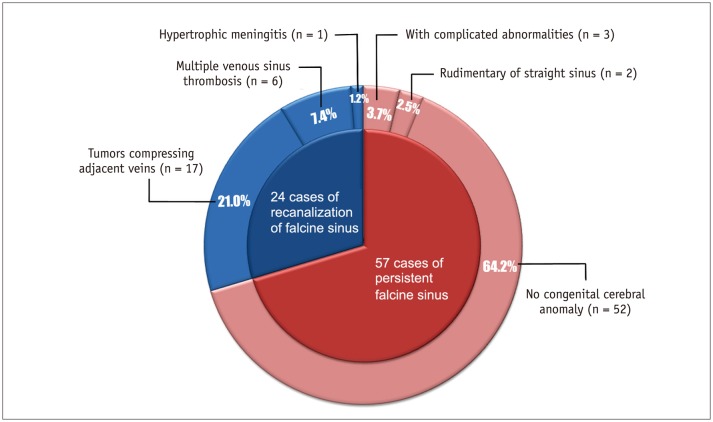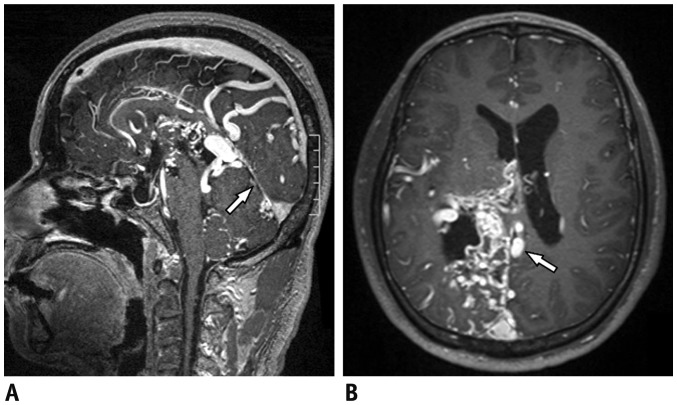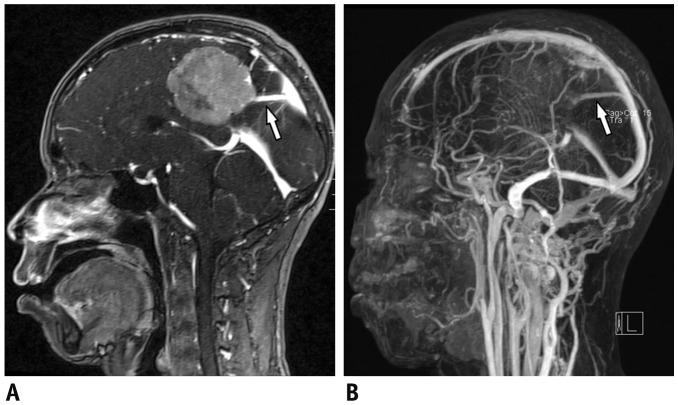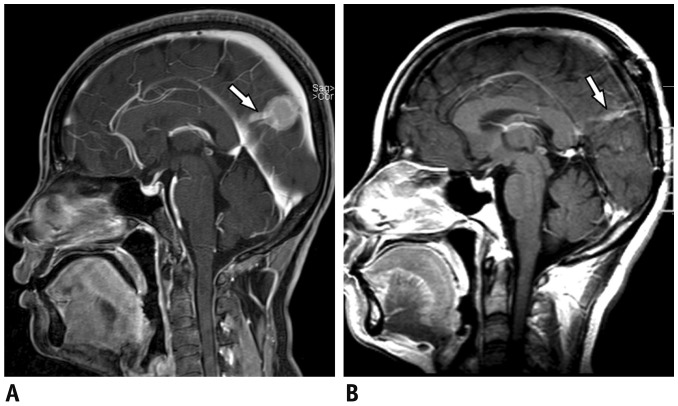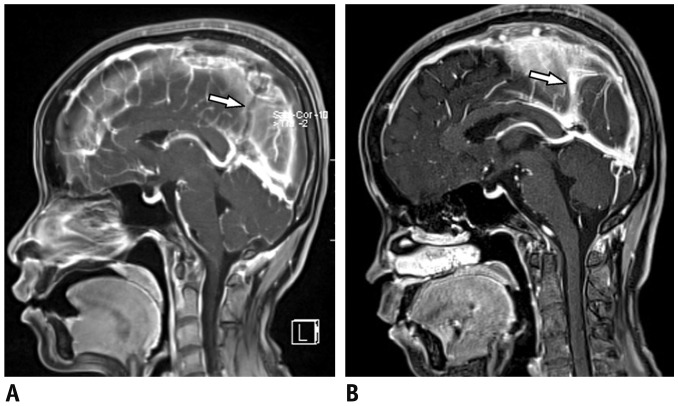Korean J Radiol.
2018 Jun;19(3):463-469. 10.3348/kjr.2018.19.3.463.
Falcine Sinus: Incidence and Imaging Characteristics of Three-Dimensional Contrast-Enhanced Thin-Section Magnetic Resonance Imaging
- Affiliations
-
- 1Department of Diagnostic Radiology, The First Affiliated Hospital of Sun Yat-Sen University, Guangzhou 510080, China. usefulkey0077@163.com
- 2Department of Ultrasonography, The First Affiliated Hospital of Sun Yat-Sen University, Guangzhou 510080, China.
- KMID: 2410817
- DOI: http://doi.org/10.3348/kjr.2018.19.3.463
Abstract
OBJECTIVE
To evaluate the incidence, characteristics, and variations of the falcine sinus with contrast-enhanced three-dimentional (3D) thin-section magnetic resonance (MR) images.
MATERIALS AND METHODS
retrospective review identified 1531 patients (745 males and 786 females, 2 months to 85 years) who underwent cranial MR imaging including T1-weighted imaging, T2-weighted imaging, T2-weighted fluid-attenuated inversion recovery, contrast-enhanced 3D thin-section sagittal scans, and MR venography, from June 2014 to January 2016. The incidence, characteristics of the falcine sinus, and coexisted intracranial lesions were confirmed by two neuroradiologists.
RESULTS
Falcine sinuses were identified in 81 (38 males and 43 females) cases (5.3%, 81/1531, 5 months to 76 years of age) with calibers ranging from 2.3 mm to 17.0 mm. Three major forms of falcine sinuses were defined: arch-like (n = 47), stick-like (n = 22), and bifurcated (n = 12). Persistent falcine sinuses were found in 57 cases, among which 3 cases showed complicated cerebral anomalies, and 2 cases showed smaller straight sinuses. Recanalization of falcine sinuses were found in 24 cases, including 17 cases with tumor compression, 6 cases with cerebral venous sinus thrombosis, and one case with hypertrophic meningitis.
CONCLUSION
Falcine sinus is not as rare as has been reported previously. Most falcine sinuses are not associated with congenital cerebral abnormalities. Diseases that cause increased pressure in the venous sinus may lead to recanalization of falcine sinus. Illustrating the characteristics of falcine sinus may prompt a more comprehensive understanding and diagnosis of associated diseases, and avoid potential surgical damage in the future.
Keyword
MeSH Terms
Figure
Reference
-
1. Kesava PP. Recanalization of the falcine sinus after venous sinus thrombosis. AJNR Am J Neuroradiol. 1996; 17:1646–1648. PMID: 8896615.2. Desprechins B, Debaere C, Machiels F, Bougatef A, Osteaux M. A vein of Galen aneurysm with an abnormal drain system: MRI findings. Pediatr Radiol. 1995; 25:442–443. PMID: 7491195.
Article3. Ratliff J, Voorhies RM. Arteriovenous fistula with associated aneurysms coexisting with dural arteriovenous malformation of the anterior inferior falx. Case report and review of the literature. J Neurosurg. 1999; 91:303–307. PMID: 10433319.4. Manoj KS, Krishnamoorthy T, Thomas B, Kapilamoorthy TR. An incidental persistent falcine sinus with dominant straight sinus and hypoplastic distal superior sagittal sinus. Pediatr Radiol. 2006; 36:65–67. PMID: 16283283.
Article5. Abe T, Matsumoto K, Kiyota K, Tanaka H. Vein of Galen aneurysmal malformation in an adult: a case report. Surg Neurol. 1996; 45:39–43. PMID: 9190697.
Article6. Bartels RH, Merx JL, van Overbeeke JJ. Falcine sinus and occipital encephalocele: a magnetic resonance venography study. J Neurosurg. 1998; 89:738–741. PMID: 9817410.
Article7. Kim MS, Lee GJ. Two cases with persistent falcine sinus as congenital variation. J Korean Neurosurg Soc. 2010; 48:82–84. PMID: 20717519.
Article8. Reddy AT, Hedlund GL, Percy AK. Enlarged parietal foramina: association with cerebral venous and cortical anomalies. Neurology. 2000; 54:1175–1178. PMID: 10720293.
Article9. Sener RN. Association of persistent falcine sinus with different clinicoradiologic conditions: MR imaging and MR angiography. Comput Med Imaging Graph. 2000; 24:343–348. PMID: 11008182.
Article10. Cai CQ, Zhang QJ, Yang WD, Wang CX, Shen CH. Neuroimages of persistent falcine sinus in children. World J Pediatr. 2009; 5:63–64. PMID: 19172336.
Article11. Yang CA, Peng SS, Hsieh WS, Tsao PN, Chen CY, Chou HC. Large parietal midline defect with unusual ridge-like structure at the rim and persistent falcine sinus. Childs Nerv Syst. 2013; 29:1069–1072. PMID: 23559396.
Article12. Strub WM, Leach JL, Tomsick TA. Persistent falcine sinus in an adult: demonstration by MR venography. AJNR Am J Neuroradiol. 2005; 26:750–751. PMID: 15814916.13. Kashimura H, Arai H, Ogasawara K, Ogawa A. Persistent falcine sinus associated with obstruction of the superior sagittal sinus caused by meningioma--case report. Neurol Med Chir (Tokyo). 2007; 47:83–84. PMID: 17317947.
Article14. Smith A, Choudhary AK. Prevalence of persistent falcine sinus as an incidental finding in the pediatric population. AJR Am J Roentgenol. 2014; 203:424–425. PMID: 25055280.
Article15. Ryu CW. Persistent falcine sinus: is it really rare? AJNR Am J Neuroradiol. 2010; 31:367–369. PMID: 19779000.
Article
- Full Text Links
- Actions
-
Cited
- CITED
-
- Close
- Share
- Similar articles
-
- Dynamic Contrast-Enhanced MR Imaging of Tietze’s Syndrome: a Case Report
- Characteristics of Magnetic Resonance(M.R.) and Comprehension of its Imaging Mechanism
- Recent development of diagnostic imaging of hepatocellular carcinoma
- Molecular MR Imaging
- MR Images of Spontaneously Involuted Atretic Cephalocele Concomitant with Persistent Falcine Sinus in an Adult

